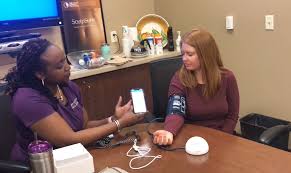Source: capitalgazette.com
Remote blood pressure monitoring is part of a pilot program at Anne Arundel Medical Center for new mothers during their fourth trimester, the first three months after a baby is born.
The monitors, which would connect to patients’ phones via Bluetooth, would transmit data to registered nurses who monitor the data during business hours and serve as a “safety blanket” for new mothers.
Twenty percent of pregnancies are affected by hypertensive disorders, according to Dr. Ifeyinwa Stitt, OB-GYN specialist at Anne Arundel County Medical Center.
“In the postpartum period, you are at the highest risk and you’re no longer worried about yourself but more worried about your newborn,” Stitt said. “The fourth trimester can be the most dangerous portion of a pregnancy. We see women with higher incidences of strokes, heart attacks and other hypertension disorders that go unnoticed.”
The physicians can see if there are any changes that need to be made by monitoring the reports through the device. “That way that mom can focus her baby and still be taking care of themselves in the background,” Stitt said.
If a patient is not recording data, the office will call them or message them via the MyChart app.
“We are trying to utilize all the technology that is available to us,” Stitt said. “It allows us to check on our patients and make sure they are safe.”
The program doesn’t only help patients but helps free up schedules for doctors.
“This is a two minute visit that gets blocked into a 15 minute appointment,” Stitt said. “It allows us to see patients that absolutely need to be seen. The problem we used to have before we were bringing everybody back and often times we weren’t getting to see those ones that needed to come back. They would end up in the ER.”
The monitoring program is only for after pregnancy. During pregnancy women are visiting the office weekly.
If a patient is not recording data, the office will call them or message them via the MyChart app.
“We are trying to utilize all the technology that is available to us,” Stitt said. “It allows us to check on our patients and make sure they are safe.”
The program doesn’t only help patients but helps free up schedules for doctors.
“This is a two minute visit that gets blocked into a 15 minute appointment,” Stitt said. “It allows us to see patients that absolutely need to be seen. The problem we used to have before we were bringing everybody back and often times we weren’t getting to see those ones that needed to come back. They would end up in the ER.”
The monitoring program is only for after pregnancy. During pregnancy women are visiting the office weekly.
Before this program, the postpartum visit was the least attended visit for patients, according to Stitt.
Preventing high blood pressure
High blood pressure, also called hypertension, is very common. In the United States, high blood pressure happens in 1 in every 12 to 17 pregnancies among women ages 20 to 44.
High blood pressure in pregnancy has become more common. However, with good blood pressure control, mothers and their children are more likely to stay healthy.
Doctors advise mothers to pay attention to how they feel after giving birth. If they had high blood pressure during pregnancy, they have a higher risk for stroke and other problems after delivery.
The CDC recommends individuals live a healthy lifestyle by avoiding smoking, maintain a healthy weight alongside regular physical activity and get enough sleep. Not getting enough sleep on a regular basis is linked to an increased risk of heart disease, high blood pressure, and stroke.
